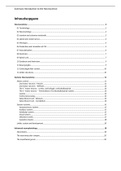Samenvatting
Samenvatting introduction into the Neuroscience
- Instelling
- Universiteit Leiden (UL)
Dit document is een uitgebreide samenvatting van alle colleges en kennisclips die gegeven worden tijdens het vak Introduction into the Neuroscience. Bevat een duidelijke inhoudsopgave dat het studeren overzichtelijk maakt.
[Meer zien]





